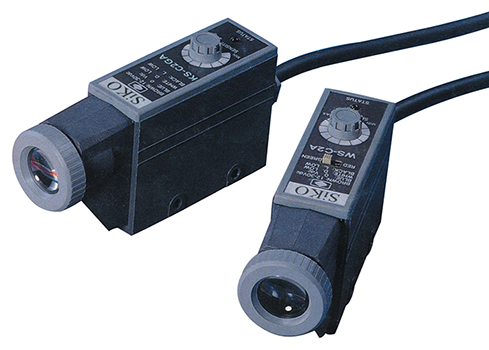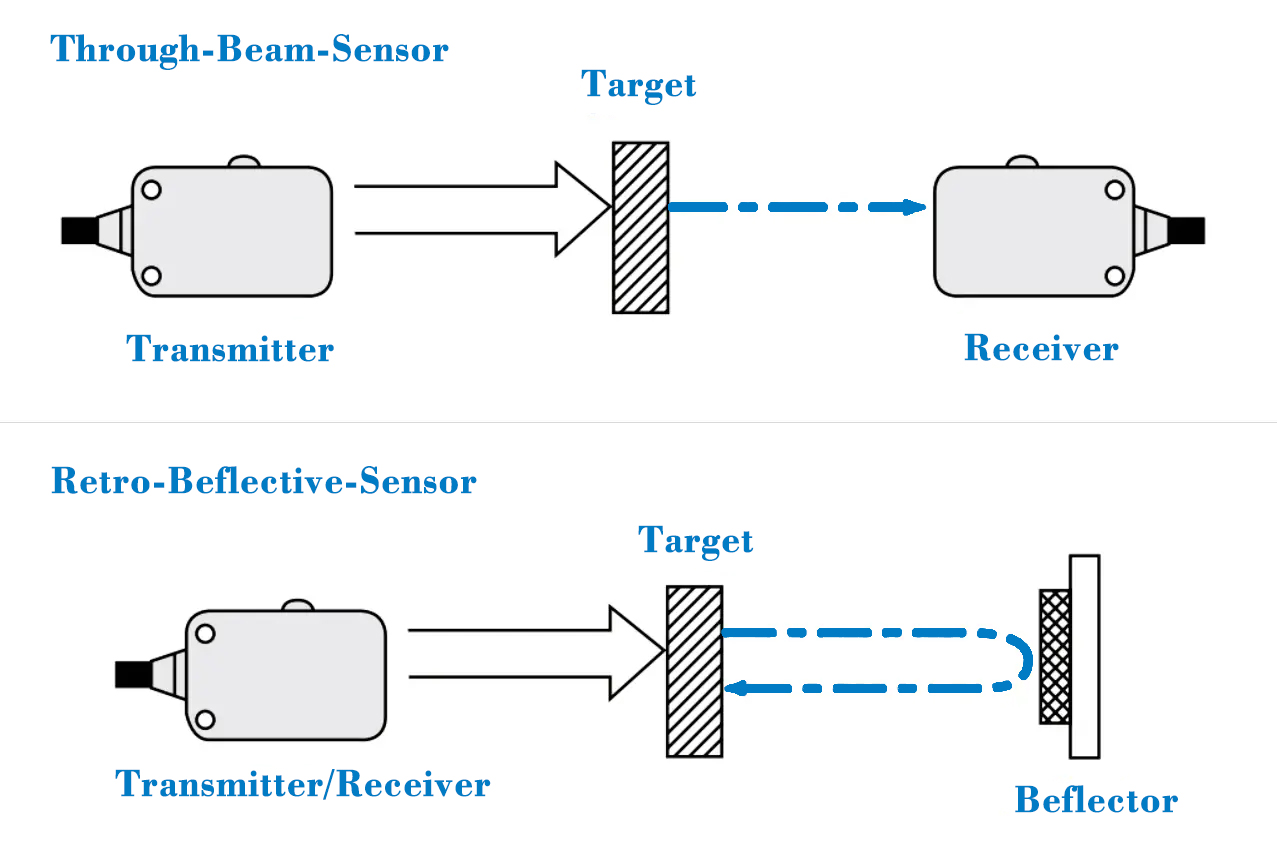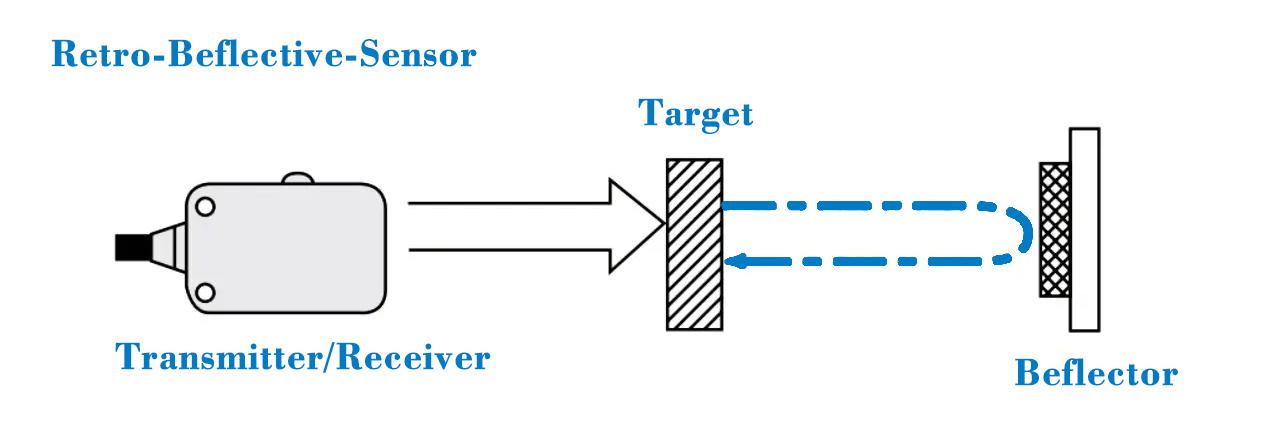Photoelectric sensors play a crucial role in various industries, providing reliable and efficient detection capabilities for automation and control systems. This article aims to explore the working principles, types, applications, advantages, limitations, selection, installation, and emerging trends of photoelectric sensors.

What is Photoelectric Sensors?
A photoelectric sensor is a device that converts light signals into electrical signals. Its working principle is based on the photoelectric effect. The photoelectric effect refers to that when light is irradiated on certain substances, the electrons of the substance absorb the energy of photons and a corresponding electric effect occurs. According to the different phenomena of photoelectric effect, photoelectric effect can be divided into three categories: external photoelectric effect, internal photoelectric effect and photovoltaic effect. Photoelectric devices include phototubes, photomultiplier tubes, photoresistors, photodiodes, phototransistors, and photocells. The performance and characteristic curves of optoelectronic devices are analyzed.
Working Principles of Photoelectric Sensors
Photoelectric sensors are controlled by converting changes in light intensity into changes in electrical signals.
In general, photoelectric sensors are composed of three parts, which are divided into: transmitter, receiver and detection circuit.
The transmitter aligns the target to emit light beams, and the emitted light beams generally come from semiconductor light sources, light emitting diodes (LEDs), laser diodes and infrared emitting diodes. The beam is emitted continuously, or with varying pulse width. The receiver consists of a photodiode, a phototransistor and a photocell. In front of the receiver, optical components such as lenses and apertures are installed. Following it is the detection circuit, which filters out the valid signal and applies it.

In addition, there are emission plates and optical fibers among the structural components of the photoelectric switch.
Categories and How They Work
1. Slot photoelectric sensor
Install an optical transmitter and a receiver face to face on both sides of a slot to form a slot photoelectric. The emitter can emit infrared light or visible light, and the light receiver can receive the light under unobstructed conditions. But when the object to be detected passes through the slot, the light is blocked, the photoelectric switch will act, and output a switch control signal to cut off or connect the load current, thus completing a control action. The detection distance of the slot switch is generally only a few centimeters due to the limitation of the overall structure.
2. For the through-beam photoelectric sensor
If the emitter and the receiver are separated, the detection distance can be increased. An emitter and a receiver form a separate through-beam photoelectric switch, referred to as the through-beam photoelectric switch. The detection distance of the through-beam photoelectric switch can reach several meters or even tens of meters. When using the through-beam photoelectric switch, the light emitter and the light receiver are respectively installed on both sides of the path through which the detection object passes. When the detection object passes through to block the light path, the light receiver will act and output a switch control signal.

3. Reflector type photoelectric switch
Put the light emitter and the light receiver into the same device, install a reflector in front, and use the reflection principle to complete the photoelectric control function, which is called reflector reflective (or mirror reflective) photoelectric switch. Under normal circumstances, the light source emitted by the emitter is reflected by the reflector and then received by the receiver; once the light path is blocked by the detected object and the receiver cannot receive light, the photoelectric switch will act and output a switch control signal.

4. Diffuse reflective photoelectric switch
The detection head of the diffuse reflective photoelectric switch is also equipped with an emitter and a light receiver, but there is no reflective plate in front of the diffuse reflective photoelectric switch. Under normal circumstances, the light receiver emitted by the emitter cannot be found. During detection, when the detection object passes through and blocks the light, and part of the light is reflected back, the light receiver receives the light signal and outputs a switch signal.
Applications of Photoelectric Sensors
1. Smoke and dust turbidity monitor
Preventing industrial dust pollution is one of the important tasks of environmental protection. In order to eliminate industrial smoke and dust pollution, we must first know the amount of smoke and dust emissions, so the source of smoke and dust must be monitored, automatically displayed and alarmed for exceeding the standard. The smoke turbidity in the flue is detected by the change in the light transmission process in the flue. If the flue turbidity increases, the light emitted by the light source is absorbed and refracted by the smoke particles, and the light reaching the photodetector decreases, so the intensity of the output signal of the photodetector can reflect the change of flue turbidity.
2. Barcode scanner
When the scanning pen head moves on the barcode, if it encounters a black line, the light of the light-emitting diode will be absorbed by the black line, and the photosensitive transistor cannot receive the reflected light, showing high impedance and being in the cut-off state. When encountering the white interval, the light emitted by the light-emitting diode is reflected to the base of the phototransistor, and the phototransistor generates photocurrent and conducts. After the entire barcode has been scanned, the phototransistor transforms the barcode into electrical pulse signals. After the signal is amplified and shaped, it forms a pulse train, which is then processed by a computer to complete the identification of the barcode information.
3. Product counter
When the product is running on the conveyor belt, it continuously blocks the optical path from the light source to the photoelectric sensor, so that the photoelectric pulse circuit generates electrical pulse signals one by one. Every time the product is shaded, the photoelectric sensor circuit will generate a pulse signal. Therefore, the number of output pulses represents the number of products. The pulses are counted by the counting circuit and displayed by the display circuit.
4. Photoelectric smoke alarm
When there is no smoke, the light emitted by the light-emitting diodes travels in a straight line, and the phototransistors do not receive signals. When there is no output and there is smoke, the light emitted by the light-emitting diode is refracted by the smoke particles, so that the triode receives the light, there is a signal output, and an alarm is issued.
5. Measuring speed
Paint black and white two colors on the rotating shaft of the motor. When rotating, the reflected light and non-reflected light appear alternately. The photoelectric sensor correspondingly intermittently receives the reflected light signal and outputs intermittent electrical signals, which are then amplified by the amplifier and the shaping circuit. Reshape the output square wave signal, and finally output the rotational speed of the motor by the electronic digital display.
6. Application of photoelectric cells in photoelectric detection and automatic control
When photocells are used as photodetectors, their basic principles are the same as photodiodes, but their basic structures and manufacturing processes are not exactly the same. Since the photocell does not require an external voltage when it works; it has high photoelectric conversion efficiency, wide spectral range, good frequency characteristics, and low noise. , UV monitors and flameout protection devices for gas turbines, etc.
Advantages and Limitations of Photoelectric Sensors
Understanding the strengths and weaknesses of photoelectric sensors helps in evaluating their suitability for specific applications.
1). Advantages:
Photoelectric sensors offer several advantages that contribute to their widespread adoption:
1. High Precision and Accuracy:
Photoelectric sensors provide precise and accurate object detection, ensuring reliable performance in various applications.
2. Non-contact Operation and Environmental Resistance:
They operate without physical contact with the target object, minimizing wear and tear. Additionally, photoelectric sensors are designed to withstand challenging environmental conditions.
3. Wide Range of Detection Capabilities:
Photoelectric sensors offer adjustable sensitivity and can detect objects at varying distances, allowing for flexibility in different application scenarios.
2). Limitations and Considerations:
While photoelectric sensors have numerous advantages, it is important to be aware of their limitations and factors that can affect their performance:
1. Factors Influencing Sensor Performance:
Various factors, such as ambient light levels, reflective surfaces, and object characteristics, can impact the performance of photoelectric sensors.
2. Challenges in Detecting Transparent or Reflective Objects:
Transparent or reflective objects can pose challenges for photoelectric sensors, as they may not provide sufficient contrast for reliable detection.
Selection and Installation of Photoelectric Sensors
Choosing the right photoelectric sensor and properly installing it are critical for achieving optimal performance.
1). Factors to Consider:
Several factors should be taken into account when selecting a photoelectric sensor for a specific application, including:
1. Target Characteristics and Sensing Range:
The characteristics of the objects to be detected, along with the required sensing range, play a crucial role in sensor selection.
2. Environmental Conditions and Ambient Light Interference:
Environmental conditions, such as extreme temperatures or excessive ambient light, should be considered to ensure the sensor operates effectively.
3. Output Requirements and Compatibility:
The desired output type and compatibility with control systems are important factors to consider during sensor selection.
2). Installation Best Practices:
Proper installation and calibration are essential for achieving accurate and reliable performance from photoelectric sensors. This section provides best practices for positioning, alignment, and optimization of sensor performance.
Conclusion
In conclusion, photoelectric sensors play a vital role in automation and control systems, enabling reliable object detection, presence sensing, proximity sensing, and measurement in various industries. Understanding their working principles, types, applications, advantages, and limitations is crucial for selecting the right sensor for specific tasks. Additionally, proper installation, calibration, and awareness of emerging trends contribute to maximizing the potential of photoelectric sensors in future industrial applications. As technology continues to evolve, photoelectric sensors will continue to play a significant role in advancing automation, efficiency, and precision in various domains.

Nantian Electronics a professional distributor of electronic components, providing a wide range of electronic products, saving you a lot of time, effort and cost through our meticulous order preparation and fast delivery service.
Share this post


